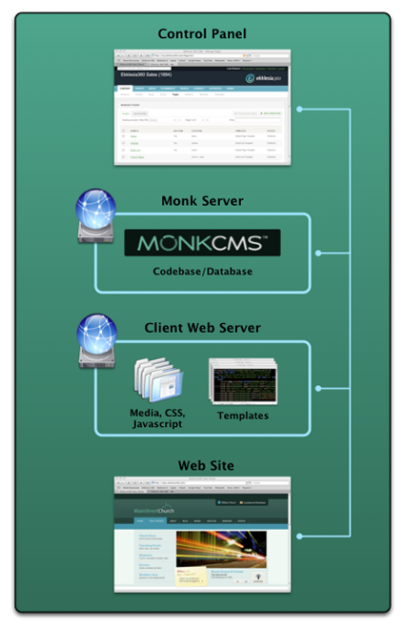CMS Overview
There are several elements that work together in MonkCMS to create what the user sees on your website. If you have worked with other Content Management Systems (CMS's) before, you will be familiar with most of the following concepts, though there are significant differences to our system that offer some unique advantages to the development of your site.

The following elements comprise the foundation for MonkCMS:
- Control Panel - Also often referred to as the "back end", this is a user-friendly interface where the site admins are able to enter and manage content and site settings.
- Central Database - Similar to most systems, MonkCMS stores all site settings and content in a database. However, in contrast to most other CMS installs, the database is central to all MonkCMS sites and is independent from the web server that hosts the site.
- Application Codebase - The PHP files that run MonkCMS and direct the flow of data between the Control Panel, Database and Web Server. Just like the database, the codebase lives on a central server and is accessed via a special php file that resides on the local web host.
- Web server - Where the "front end" of the site lives. It includes all of the site templates, mirrored copies of media (which also resides on the central server for content syndication, see benefits below), .htaccess file, cache, and the monkcms.php file that interacts with the codebase and database.
Benefits of the MonkCMS Infrastructure
- No software installs. There is no need to install any source code or database software at the client website.
- Automatic updates. Bug fixes and feature releases happen automatically as there is no need to push out updates to scattered source bases. A robust release cycle ensures that all versions are of the highest quality.
- Sophisticated caching. All queries from the client website to the CMS are cached in a secure fashion so as to ensure that there are not redundant requests to the server as well as improving web site speeds and working towards 99.9% uptime of customer websites
- Disaster recovery. Data is backed up according to a strict Disaster Recovery policy shifting the burden of data backup and maintenance from the customer to the CMS system.
- Syndication & SEO. Clients have the option of opting into the various networks that help syndicate their content into relevant sites that may spread the word about products, messages, ideas much faster than simple link development. All sites using MonkCMS are built on the same database which provides the strictest privacy on one hand, but massive content syndication on another. This is by no means a replacement for link development, but goes a very long way in advertising and marketing. Once more sites link to the client site, combined with strict XHTML and CSS development, the SEO kicks in and provides a higher ranking in search results.
